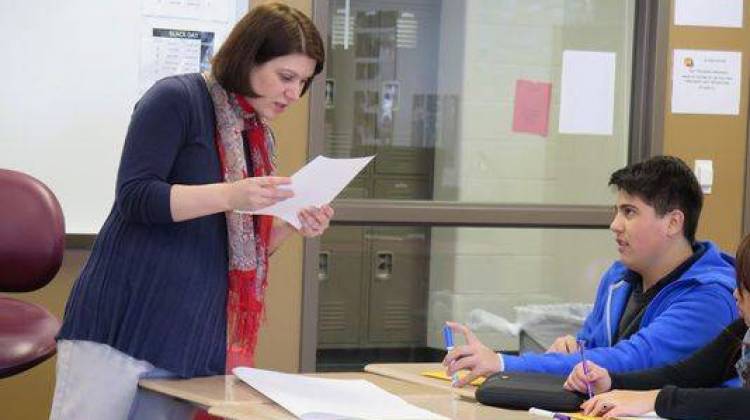
Amy Peddie, seen helping a student with an assignment at Southport High School, helped shape the English language learning program there. “I’d never teach anything else now,†said Peddie, 39. “I love it.â€
Shaina Cavazos/Chalkbeat IndianaAmy Peddie had a hand in shaping Southport High School's program to help kids learn to speak English, but she almost said no to working with language learners at all.
"I don't know how," she remembered thinking. "I've never taught that before."
The influx of immigrant students in Perry Township has placed a special pressure on teachers who previously didn't need specialized training in working with English language learners. What they learned as the number of such students grew has benefited the students and their teachers.
But initially, Peddie was so intimidated that she thought about quitting teaching.
Instead, she took the job, earned a master's degree from Indiana University and added a certificate to her teaching license identifying her as an expert in English language learning.
"I'd never teach anything else now," Peddie said. "I love it."
Teachers in Perry Township schools often find themselves in an intimidating position — responsible for a room of children who speak a variety of foreign languages. It's Peddie's job to keep that from feeling overwhelming.
It's not like teaching French and Spanish to American students. There are too many languages and not enough bilingual teachers.
"You can't do that times 67 languages," said Jane Pollard, who helps train Perry Township teachers. "It was really going to be about teaching best practice and best protocols of teaching languages."
Knowing a student's native language isn't enough anyway.
By employing broad strategies and specific techniques in their lessons, teachers can push children from around the world toward a common understanding of the basics of English while they learn other subjects at the same time.
There are many techniques, including some that seem simple. Teachers talk slowly, repeat themselves and pronounce words carefully. They use their hands and visual images to get ideas across. They retool lessons so their students learn the same concepts as their peers, but in simplified language, and they use different sorts of tests.
Most of all, they try to get their students working together, helping each other and capitalizing on what they already know.
"When kids walk in my class, I tell them I expect them to go to college, even if I know some of them might not make it," Peddie said. "So I think part of it is just about setting the expectation that they can. Can and will and do."
Training all teachers in language learning
Peddie remembers how quickly the need grew for strategies to help English language learners in Perry Township — and how hard it was.
When Peddie, 39, went on maternity leave in 2007, Southport had only 30 students learning English as a new language. When she returned the next semester, that number had grown to 120.
The entire district had to change — and fast.
Since 2001, the number of students learning English in Perry Township has grown by more than 4,000, or more than 850 percent. Many are refugees who fled civil war in Burma. Today, about one-fifth of Southport High School's students are learning to speak English.
In response, the district has pushed widespread training for all teachers in a set of strategies, known as "sheltered instruction," designed specifically to help English language learners. More than 800 of the district's teachers have been trained to teach that way.
Using visual aids, technology and collaboration
Dictionaries almost fill one bookshelf in Peddie's classroom.
They define words in Kurdish, Burmese, French, Spanish, Vietnamese, Mongolian, Arabic, Hindi, Farsi, Swahili and other languages. Even so, she doesn't have a dictionary for every language spoken at Southport.
Peddie speaks only English in her classes so students hear more English words and inflections. It's one of the strategies in a broad approach that she has found helps students the most.
In a recent lesson in Peddie's class, students were to analyze a news article about cold winters. A traditional class might cover the same ideas by reading several articles.
"I'm not sure a classroom English teacher would spend an entire day on one article, main idea and supporting details," Peddie said. "But we try to hold them to the standards. We are trying to teach the concepts, maybe not with the same curriculum, but the same ideas."
More advanced students were paired with struggling students so they could explain things such as snow or agriculture to their peers in their native language. This helps both students progress.
Up front, Peddie used an electronic whiteboard to project the article and highlight text. She also tried a different visual strategy by giving the students a word cloud — a graphic display in which the words used most frequently in the article were bigger than those used less often.
"You've done this before," she reminded the class. "So what are the biggest words on this? Cold — you're going to write down cold."
Different experiences, different teaching and different tests
Mike Klopfenstein helps train other teachers in sheltered instruction and has taught Southport's sheltered sophomore English class for a decade.
The students range from freshmen to juniors with weak English fluency. His job is to keep them on track with the same concepts their peers in regular English classes are learning.
The tasks can be challenging: analyzing readings to compare and contrast concepts, for example. The lessons must be taught in language the students can understand, he said.
"The reading level and writing expectations at the high school level are really above what these kids can do," Klopfenstein said. "Most of these kids haven't had the basics."
Klopfenstein tries to connect what his students are learning to their experiences before coming to the U.S.
"We have to tap into what they know," he said. "So I know with my students, quite often I speak to them about their lives back in Burma and try to connect things that we're teaching and we're learning with things they might be learning. I give them the opportunity to teach me."
Tests also have to take into account the way students learn. Klopfenstein's tests might seem strange to a student in a typical 10th-grade English class.
"My assessments will be a lot more visual, will require kids to use visuals or drawings," he said. "I'll ask them to explain in the best English they have and also draw it so I can see what they're thinking, even though they may not be able to express it clearly through language."
The quiet period
When teachers are new to working with English language learners, they need to guard against misconceptions, Peddie said.
Take the "quiet period."
When a student has just moved from another country and is learning a new language, it is common that they shy away from participating in class or interacting with peers and teachers.
It happens a lot at Southport. Well-trained teachers such as Peddie know it when they see it.
For her, Andre comes to mind.
Andre, whose native language is Portuguese, started school here in January after moving from Brazil. He was so quiet early on that Peddie was often unsure how much he understood in class. When asked questions, he simply nodded or shook his head without speaking.
But as the quiet period faded, Andre revealed that he knew some English. Peddie was relieved as he soon began to adapt more quickly.
By late February, Andre was animated as he worked in class. Talking with his partner, Ting Ting, he debated and discussed and asked Peddie all sorts of questions.
"All students go through culture shock," Peddie said. "For Andre, because he already had some English, it seems to be shorter for him. He has grown a lot, not only in his confidence, but in his willingness to ask questions when he doesn't understand."
Shaina Cavazos is a reporter for Chalkbeat Indiana, a nonprofit news website that reports on educational change in Indiana. Email her at scavazos@chalkbeat.org.
About the series
This is part of a series on English language learners through a collaboration of The Star, Chalkbeat Indiana and WFYI Public Media.
 DONATE
DONATE






 Support WFYI. We can't do it without you.
Support WFYI. We can't do it without you.